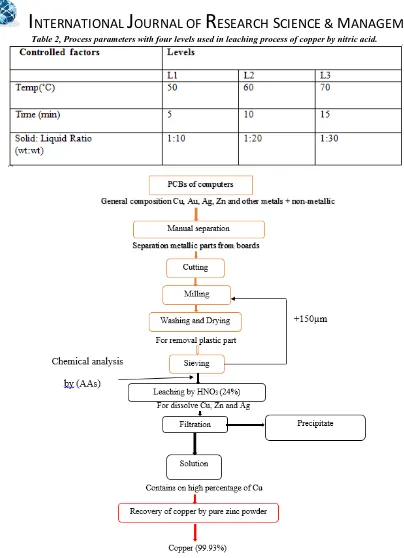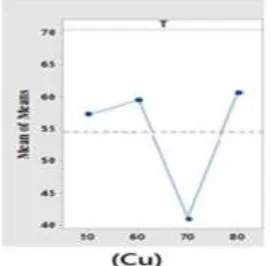[Hasson* et al., 6(9): September, 2019]
ISSN: 2349-5197
Impact Factor: 3.765
I
NTERNATIONAL
J
OURNAL OF
R
ESEARCH
S
CIENCE &
M
ANAGEMENT
RECOVERY OF COPPER FROM PRINTED CIRCUIT BOARDS OF COMPUTERS
Abbas Habeeb Hasson, Hijran Z. Toama
Department of Production Engineering and Metallurgy, University of Technology, Baghdad, Iraq
DOI: 10.5281/zenodo.3407646
Keywords: Electronic waste, PCBs, copper, recovery, Nitric acid.
Abstract
Electronic waste contains many types of metals that can be recovered. In this study the recovery of gold as a precious metal and copper as a base metal from printed circuit boards (PCBs) of consumed computers was investigated.The results of chemical analysis of (PCBs) sample, after preparation by manual separation, cutting, grinding, and sieving, showed that it contain; copper (36.268%). Hydrometallurgical method by leaching and precipitation process was applied for copper recovery. The parameters for leaching by nitric acid were; temperatures (50, 60, 70 and 80 oC), times (5, 10, 15 and 20 min), solid to liquid ratio (1:20, 1:25, 1:30 and
1:35), and at constant stirring speeds (400 rpm). The optimum parameters resulted were 50 oC temperature, 5
min time and 1:20 S:L, and the leaching efficiencies of copper 59.7% was achieved with these optimum conditions. Copper precipitation, from nitric acid solution, were conducted using pure zinc powder at room temperature without stirring for 24 hour. Recovery efficiency of copper 99.93% was achieved
Introduction
[Hasson* et al., 6(9): September, 2019]
ISSN: 2349-5197
Impact Factor: 3.765
I
NTERNATIONAL
J
OURNAL OF
R
ESEARCH
S
CIENCE &
M
ANAGEMENT
following: (1)Recovery of copper metals from printed circuit boards waste of computers by hydrometallurgical process. (2) Determining the best operational parameters of hydrometallurgical process (temperature, time, and solid/liquid ratio).
Figure (1) Generation of E-waste from 2000-2012 in united state
Experimental Work
In this study, PCBs of the consumed computers were used for recovery of the copper. The printed circuit boards for this work was obtained from consumed computers found in computers maintenance centers in local markets. The parts of copper that coated with gold in these printed circuit boards was manually separated to prepare it for the subsequent processes. Figure (2) illustrate flow diagram for recovery of copper from printed circuit of computers. Combination process is to be a two-stages, cutting, and grinding to get on the suitable particle size. To get rid of plastic parts, the powder from grinding stage was washed with distilled water in a container and leave for a day where the plastic parts are floated and removed. The residue powder placed in an electric oven at 100 ˚C for 30 min to remove moister. The dried powder was sieved to particle size less than (150) µm by using auto sieve shaker model (AD60-01). The chemical analyses of the PCBs powder is carried out by flame atomic absorption spectrometry (NOVAA-350).The analysis results are shown in table (1)as weight percentage.
Table 1,The chemical analysis for the printed circuit boards powder
Components Au Ag Cu Sn
Wt.% 0.0327% 0.0111% 36.268% 0.0430%
The samples of PCBs powder leaching with nitric acid in concentration 24% to dissolved copper and reduce the concentration of some metals such as silver and tin.
[Hasson* et al., 6(9): September, 2019]
ISSN: 2349-5197
Impact Factor: 3.765
I
NTERNATIONAL
J
OURNAL OF
R
ESEARCH
S
CIENCE &
M
ANAGEMENT
Table 2, Process parameters with four levels used in leaching process of copper by nitric acid.Figure (2)Flow sheet for recovery copper from PCBs of computers
2.1. Taguchi Design of Experiment
[Hasson* et al., 6(9): September, 2019]
ISSN: 2349-5197
Impact Factor: 3.765
I
NTERNATIONAL
J
OURNAL OF
R
ESEARCH
S
CIENCE &
M
ANAGEMENT
Table 3, Leaching process data with nitric acid used in experiments according to TOA designExp. Temp(˚C) Time(min) Solid: Liquid Ratio (wt:wt)
1 50 5 1:20
2 50 10 1:25
3 50 15 1:30
4 50 20 1:35
5 60 5 1:25
6 60 10 1:20
7 60 15 1:35
8 60 20 1:30
9 70 5 1:30
10 70 10 1:35
11 70 15 1:20
12 70 20 1:25
13 80 5 1:35
14 80 10 1:30
15 80 15 1:25
16 80 20 1:20
2.2. Leaching Process with nitric acid
The PCBs powder was dissolved in nitric acid solution with 24% concentration. The leaching process involved replication of each experiment. Two grams of prepared PCBs sample was used in leaching with nitric acid. The powder added to nitric acid 500ml glass container which has three holes for; material or reagents adding, thermometer inserting, and the last hole for condense fitting. The magnetic stirrer with heating plate was used to conduct leaching process at predetermined temperature, time, and solid to liquid ratio according to each experiment and constant agitation speed at 500 rpm for all experiments. The solution produced from leaching process were filtered using ash less Whatman filter paper, the result were subjected to chemical analysis using flame atomic absorption spectrometry. Sixteen experiments of leaching process by HNO3 was conducted
according to taguchi method, and the experiments repeated twice to obtain leaching percentage. 7- For each experiment the percentage of leaching is calculated by the following formula[10]:
Leaching =C.V
C.W 100% (1)
C= The gold concentration or copper concentration after process of the leaching (g/l),V=The solution volume of the after process of the leaching (l), W= PCBs sample weight in the solution of leaching (g) and C= The gold concentration or copper concentration in the PCBs (%).
Equation (2) to (3) show the half-reactions occurred in the HNO3 leaching process [11].
M→M2++2e- (2)
Cu + 4 HNO3 → Cu(NO3)2 + 2 H2O + 2 NO2 (3)
2.3 Recovery of copper
Pure zinc powder used as precipitant agent to precipitate copper from solution produced from leaching process with nitric acid. Five grams of pure zinc powder added to 25 ml of leachant solution diluted with 75 ml of water in a beaker for 24 hour at room temperature. After copper precipitation indicated by color change of solution, the mixture was filtered and subjected to chemical analysis using flame atomic absorption spectrometry to determine copper content and calculating coper recovery.
The copper recovery percentage can be calculated by using the following formula [10]:-
𝑅𝑒𝑐𝑜𝑣𝑒𝑟𝑦 % =𝐶1𝐿1−𝐶2𝐿2
[Hasson* et al., 6(9): September, 2019]
ISSN: 2349-5197
Impact Factor: 3.765
I
NTERNATIONAL
J
OURNAL OF
R
ESEARCH
S
CIENCE &
M
ANAGEMENT
Where:
C1= The metal concentration before process of the precipitation (g/l), L1= The solution volume before
process of the precipitation (l), C2= the metal concentration after process of the precipitation (g/l) and L2=
The solution volume after process of the precipitation (l).
The reactions of recovered copper from nitric acid solution by zinc pure powder are as Zn + Cu(NO3)2 → Cu + Zn(NO3)2 (5)
Zn(s) + Cu2+ (aq) → Zn2+ (aq) + Cu(s) (6)
Results & Discussion
3.1. Effect of time on copper leaching with HNO3
The experiments of leaching process by nitric acid solution was carried out twice at different times (5 ,10 , 15 and 20)minutes to discover the suitable time to get on the lowest percentage solubility of gold with good percentage solubility of copper during process of leaching with HNO3. Figure 4.3 shows the time effect on the process of the copper leaching with the solution of nitric acid. Leaching efficiency of copper were increasing and decreasing irregularly at different times. The percentage of copper leaching at 5 min was 53.22%.
Figure (3) Efficiency of copper leaching by nitric acid solution for every level as a function of time
3.2. Effect of the temperatures on copper leaching with HNO3
Copper leaching kinetics at four levels of the temperatures (50, 60, 70 and 80) ˚C were studied. Figure 4.3 show leaching efficiency of copper at different temperatures. The leaching kinetics of copper increasing and decreasing irregularly at different temperatures therefore the activation energy of the leaching reactions irregularly with increased temperature. Copper leaching efficiency at 50˚C 57.23% was achieved.
[Hasson* et al., 6(9): September, 2019]
ISSN: 2349-5197
Impact Factor: 3.765
I
NTERNATIONAL
J
OURNAL OF
R
ESEARCH
S
CIENCE &
M
ANAGEMENT
3.3. Effect of the solid to liquid Ratioon copper leaching with HNO3
The S/L ratio (wt:wt) is considered one of the factors affecting on the copper leaching. Four levels of S/L ratio (1:20, 1:25, 1:30 and 1:35) were studied. The effect of S/L ratio on the copper leaching is shown in figure 4.3. The mean of the leaching for copper in nitric acid solution in general increased with increased S:L ratio. Whenever the ratio of solid to liquid increase the possibility the liquid on extract and dissolve the metal required from sample also increase. Copper leaching efficiency at 1:20 S/L was about 49.21% was achieved.
Figure (5) Efficiency of copper leaching by nitric acid solution for every level as a function of solid to liquid ratio
3.4. Recovery of copper
Copper nitrate formed after the copper dissolved in nitric acid solution during the first leaching process for printed circuit boards of computes. Pure zinc powder used to precipitate copper because it has high efficiency in copper precipitate from nitrate solution. Zinc is strong reducing agent to copper (Cu+2 ) Because zinc is more
active to interact with acids as arranged in the periodic table, which comes before copper so that react with copper nitrate to release copper (Cu) and its precipitate and zinc nitrate (Zn (NO3)2) was formed. The
percentages of efficient recovery of copper (99.93%).
Conclusions
The following conclusions are drawn from this work:
1. The optimum dissolution of copper by nitric acid were 59.7%, at a time 5 minutes, temperature 50°C, and solid/liquid ratio 1/20.
2. Recovery efficiency of copper from nitric acid solution by using pure zinc powder was 99.93% at room temperature and time 24 hour.
References
[1] Baldé CP, Wang F, Kuehr R, Huisman J. The Global E-Waste Monitor–2014, United Nations University, IAS–SCYCLE. Bonn, Germany. 2015.
[2] Draft proposal for a European Parliament and Council directive on waste electrical and electronic equipment, European Commission Report Brussels, (2000).
[3] Ahmad HZ, Khan A, Raza A, Noman H, Mushtaq A. Extraction of Metals from Electronic Waste, Department of Chemical Engineering, COMSATS Institute of Information Technology, Lahore. 2015 June 29.
[4] Adediran YA, Abdulkarim A. Challenges of electronic waste management in Nigeria. International Journal of Advances in Engineering & Technology. 2012;4(1):640-8.
[5] Khaliq A, Rhamdhani MA, Brooks G, Masood S. Metal extraction processes for electronic waste and existing industrial routes: a review and Australian perspective. Resources. 2014 Feb 19;3(1):152-79. [6] PINTO, Violet N. E-waste hazard: The impending challenge. Indian journal of occupational and
environmental medicine, 2008, 12.2: 65.
[Hasson* et al., 6(9): September, 2019]
ISSN: 2349-5197
Impact Factor: 3.765
I
NTERNATIONAL
J
OURNAL OF
R
ESEARCH
S
CIENCE &
M
ANAGEMENT
[8] Delfini M, Ferrini M, Manni A, Massacci P, Piga L, Scoppettuolo A. Optimization of precious metal recovery from waste electrical and electronic equipment boards. Journal of Environmental Protection. 2011 Aug 10;2(06):675.
[9] Zhang L, Xu Z. A review of current progress of recycling technologies for metals from waste electrical and electronic equipment. Journal of Cleaner Production. 2016 Jul 20;127:19-36.
[10] Khaled AY. Separation of vanadium metal from waste burning heavy fuel of power plant. Master Thesis, Department Production Engineering and Metallurgy, University of Technology, Baghdad, Iraq, 2016.



